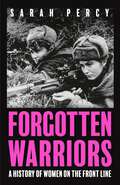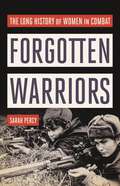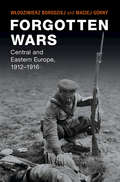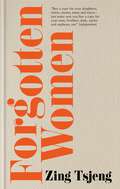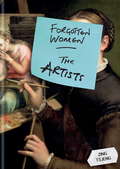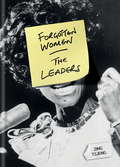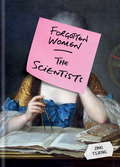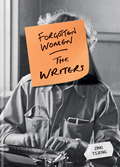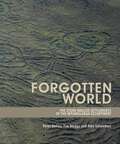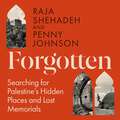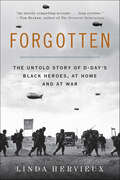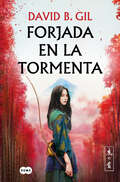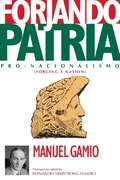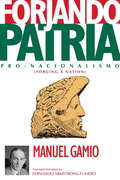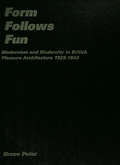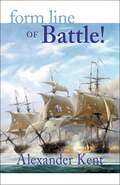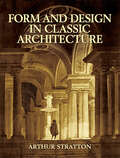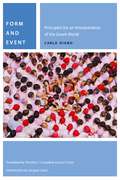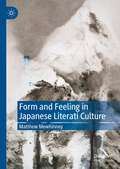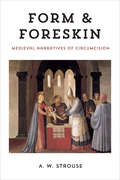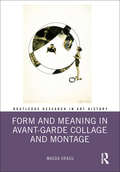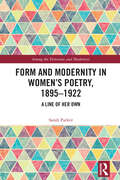- Table View
- List View
Forgotten Warriors: A History of Women on the Front Line
by Sarah PercyFrom Boudicca to Ukraine, battlefields have always contained a surprising number of women. Tracing the long history of female fighters, Forgotten Warriors puts the record straight, exploring how war became an all-male space, and getting to the bottom of why women were allowed to be astronauts a full thirty years before they were allowed to fight in combat.From the Mino, the all-female army that protected Dahomey from the West for two hundred years to the Night Witches, Soviet flying aces that decimated the Nazis; from the real story of Joan of Arc to the cross-dressing soldiers whose disguises were so effective the men around them never realized who they were fighting with, Sarah Percy shines a fascinating new light on the history of warfare. And against a backdrop of sieges and desperate battles, rebellions and civil wars, a series of extraordinary women come alive on the page, determined not to be passive victims.Every country has their tomb to the unknown warrior, picking out one unnamed body to represent the sacrifices of thousands of others. As Forgotten Warriors shows, those overlooked soldiers could well be female. Their heroic and compelling stories need to be heard.
Forgotten Warriors: The Long History of Women in Combat
by Sarah PercyThe definitive history of women in war, revealing how women have always been an essential part of combat From Boudicca&’s rebellion to the war in Ukraine, battlefields have always contained a surprising number of women. Some formed all-female armies, like the Dahomey Mino of West Africa; some fought disguised as men; some mobilized in times of national survival, like the Soviet flying aces known as the Night Witches. International relations expert Sarah Percy unearths the stories of these forgotten warriors. She sets the historical record straight, revealing that women&’s exclusion from active combat in the late nineteenth and early twentieth centuries is a blip in a much longer narrative of female inclusion. Deeply researched and brilliantly told, Forgotten Warriors turns the notion of war as a man&’s game on its head and restores women to their rightful place on the front lines of history.
Forgotten Wars: Central and Eastern Europe, 1912–1916 (Studies in the Social and Cultural History of Modern Warfare)
by Włodzimierz Borodziej Maciej GórnyWłodzimierz Borodziej and Maciej Górny set out to salvage the historical memory of the experience of war in the lands between Riga and Skopje, beginning with the two Balkan conflicts of 1912–1913 and ending with the death of Emperor Franz Joseph in 1916. The First World War in the East and South-East of Europe was fought by people from a multitude of different nationalities, most of them dressed in the uniforms of three imperial armies: Russian, German, and Austro-Hungarian. In this first volume of Forgotten Wars, the authors chart the origins and outbreak of the First World War, the early battles, and the war's impact on ordinary soldiers and civilians through to the end of the Romanian campaign in December 1916, by which point the Central Powers controlled all of the Balkans except for the Peloponnese. Combining military and social history, the authors make extensive use of eyewitness accounts to describe the traumatic experience that established a region stretching between the Baltic, Adriatic, and Black Seas.
Forgotten Women
by Zing Tsjeng'To say this [book] is "empowering" doesn't do it justice. Buy a copy for your daughters, sisters, mums, aunts and nieces - just make sure you buy a copy for your sons, brothers, dads, uncles and nephews, too.' - indy100'Here's to no more forgotten women.' - Evening StandardForgotten Women reaches around the world and its history to rediscover, retell and reinstate the lives of over 190 important and significant women. From Neolithic times to modernity, Zing Tsjeng has traced the women who have shaped their age and revolutionised society. In this book lies the strength, lives and sacrifices of women who have refused to accept the hand they've been dealt and have changed the course of our futures accordingly.
Forgotten Women
by Zing Tsjeng'To say this [book] is "empowering" doesn't do it justice. Buy a copy for your daughters, sisters, mums, aunts and nieces - just make sure you buy a copy for your sons, brothers, dads, uncles and nephews, too.' - indy100'Here's to no more forgotten women.' - Evening StandardForgotten Women reaches around the world and its history to rediscover, retell and reinstate the lives of over 190 important and significant women. From Neolithic times to modernity, Zing Tsjeng has traced the women who have shaped their age and revolutionised society. In this book lies the strength, lives and sacrifices of women who have refused to accept the hand they've been dealt and have changed the course of our futures accordingly.
Forgotten Women: The Artists (Forgotten Women)
by Zing Tsjeng'To say this series is "empowering" doesn't do it justice. Buy a copy for your daughters, sisters, mums, aunts and nieces - just make sure you buy a copy for your sons, brothers, dads, uncles and nephews, too.' - IndependentThe women who shaped and were erased from our history.Forgotten Women is a new series of books that uncover the lost herstories of influential women who have refused over hundreds of years to accept the hand they've been dealt and, as a result, have formed, shaped and changed the course of our futures.The Artists brings together the stories of 48* brilliant woman artists who made huge yet unacknowledged contributions to the history of art, including Camille Claudel, the extraordinarily talented sculptor who was always unfairly overshadowed by her lover, Rodin; Baroness Elsa von Freytag-Loringhoven, who has been claimed as the true originator of Marcel Duchamp's Fountain; and Ana Mendieta, the Cuban refugee who approached violence against women through her performance art before her own untimely death. With chapters ranging from Figurative to Photography, and Craft to Conceptual, this is an alternative guide to art history that demonstrates the broad range of artistic movements that included, and were often pioneered by, female artists who have been largely overlooked.*The number of Nobel-prize-winning women.
Forgotten Women: The Leaders (Forgotten Women Ser.)
by Zing Tsjeng'To say this series is "empowering" doesn't do it justice. Buy a copy for your daughters, sisters, mums, aunts and nieces - just make sure you buy a copy for your sons, brothers, dads, uncles and nephews, too.' - indy100The women who shaped and were erased from our history.The Forgotten Women series will uncover the lost histories of the influential women who have refused over hundreds of years to accept the hand they've been dealt and, as a result, have formed, shaped and changed the course of our futures. The Leaders weaves together 48* unforgettable portraits of the true pioneers and leaders who made huge yet unacknowledged contributions to history, including:Grace O'Malley, the 16th century Irish pirate queenSylvia Rivera, who spearheaded the modern transgender rights movementAgent 355, the unknown rebel spy who played a pivotal role in the American RevolutionNoor Inayat Khan, who went undercover to spy for the French Resistance and became Nazi enemy no. 1Amina of Zazzau, the formidable ancient Muslim warrior queen of Northern NigeriaChapters including Rebels; Warriors; Rulers; Activists and Reformers shine a spotlight on the rebellious women who defied the odds, and the opposition, to change the world around them. *The number of Nobel-prize-winning women.
Forgotten Women: The Leaders (Forgotten Women)
by Zing TsjengSelected for the Evening Standard present gift guide of the year'To say this series is "empowering" doesn't do it justice. Buy a copy for your daughters, sisters, mums, aunts and nieces - just make sure you buy a copy for your sons, brothers, dads, uncles and nephews, too.' - indy100'Here's to no more forgotten women.' Evening StandardThe women who shaped and were erased from our history.The Forgotten Women series will uncover the lost histories of the influential women who have refused over hundreds of years to accept the hand they've been dealt and, as a result, have formed, shaped and changed the course of our futures. The Leaders weaves together 48* unforgettable portraits of the true pioneers and leaders who made huge yet unacknowledged contributions to history, including:Grace O'Malley, the 16th century Irish pirate queenSylvia Rivera, who spearheaded the modern transgender rights movementAgent 355, the unknown rebel spy who played a pivotal role in the American RevolutionNoor Inayat Khan, who went undercover to spy for the French Resistance and became Nazi enemy no. 1Amina of Zazzau, the formidable ancient Muslim warrior queen of Northern NigeriaChapters including Rebels; Warriors; Rulers; Activists and Reformers shine a spotlight on the rebellious women who defied the odds, and the opposition, to change the world around them. *The number of Nobel-prize-winning women.
Forgotten Women: The Scientists
by Zing Tsjeng'To say this series is "empowering" doesn't do it justice. Buy a copy for your daughters, sisters, mums, aunts and nieces - just make sure you buy a copy for your sons, brothers, dads, uncles and nephews, too.' - indy100'Here's to no more forgotten women.' Evening StandardThe women who shaped and were erased from our history.The Forgotten Women series will uncover the lost histories of the influential women who have refused over hundreds of years to accept the hand they've been dealt and, as a result, have formed, shaped and changed the course of our futures. The Scientists celebrates 48* unsung scientific heroines whose hugely important, yet broadly unacknowledged or incorrectly attributed, discoveries have transformed our understanding of the scientific world. Mary Anning, the amateur paleontologist whose fossil findings changed scientific thinking about prehistoric life Emmy Noether, dubbed "The Mighty Mathematician You've Never Heard Of"Ynés Mexía, the Mexican-American botanist who discovered over 500 new plant species Wangari Maathai, who started an environmental and ecological revolution in KenyaMargaret Sanger, the maverick nurse who paved the way for the legalization of contraceptionChapters including Earth & Universe; Biology & Natural Sciences; Medicine & Psychology; Physics & Chemistry; Mathematics and Technology & Inventions profile the female scientists who have defied the odds, and the opposition, to change the world around us.*The number of Nobel-prize-winning women.
Forgotten Women: The Scientists (Forgotten Women)
by Zing Tsjeng'To say this series is "empowering" doesn't do it justice. Buy a copy for your daughters, sisters, mums, aunts and nieces - just make sure you buy a copy for your sons, brothers, dads, uncles and nephews, too.' - indy100'Here's to no more forgotten women.' Evening StandardThe women who shaped and were erased from our history.The Forgotten Women series will uncover the lost histories of the influential women who have refused over hundreds of years to accept the hand they've been dealt and, as a result, have formed, shaped and changed the course of our futures. The Scientists celebrates 48* unsung scientific heroines whose hugely important, yet broadly unacknowledged or incorrectly attributed, discoveries have transformed our understanding of the scientific world. Mary Anning, the amateur paleontologist whose fossil findings changed scientific thinking about prehistoric life Emmy Noether, dubbed "The Mighty Mathematician You've Never Heard Of"Ynés Mexía, the Mexican-American botanist who discovered over 500 new plant species Wangari Maathai, who started an environmental and ecological revolution in KenyaMargaret Sanger, the maverick nurse who paved the way for the legalization of contraceptionChapters including Earth & Universe; Biology & Natural Sciences; Medicine & Psychology; Physics & Chemistry; Mathematics and Technology & Inventions profile the female scientists who have defied the odds, and the opposition, to change the world around us.*The number of Nobel-prize-winning women.
Forgotten Women: The Writers (Forgotten Women)
by Zing Tsjeng'To say this series is "empowering" doesn't do it justice. Buy a copy for your daughters, sisters, mums, aunts and nieces - just make sure you buy a copy for your sons, brothers, dads, uncles and nephews, too.' - IndependentThe women who shaped and were erased from our history.Forgotten Women is a new series of books that uncover the lost herstories of influential women who have refused over hundreds of years to accept the hand they've been dealt and, as a result, have formed, shaped and changed the course of our futures. The Writers celebrates 48* unsung genius female writers from throughout history and across the world, including the Girl Stunt Reporters, who went undercover to write exposés on the ills of 1890s America; Aemilia Lanyer, the contemporary of Shakespeare whose polemical re-writing of The Bible's Passion Story is regarded as one of the earliest feminist works of literature; and Sarojini Naidu, the freedom fighter and 'Nightingale of India' whose poetry echoed her political desire for Indian independence.Including writers from across a wide spectrum of disciplines including poets, journalists, novelists, essayists and diarists, this is an alternative gynocentric history of literature that will surprise, empower, and leave you with a reading list a mile long.*The number of Nobel-prize-winning women.
Forgotten World: The Stone-Walled Settlements of the Mpumalanga Escarpment
by Peter Delius Tim Maggs Alex SchoemanIf you drive through Mpumalanga with an eye on the landscape flashing by, you may see, near the sides of the road and further away on the hills above and in the valleys below, fragments of building in stone as well as sections of stone-walling breaking the grass cover. Endless stone circles, set in bewildering mazes and linked by long stone passages, cover the landscape stretching from Ohrigstad to Carolina, connecting over 10 000 square kilometres of the escarpment into a complex web of stone-walled homesteads, terraced fields and linking roads. Oral traditions recorded in the early twentieth century named the area Bokoni – the country of the Koni people. Few South Africans or visitors to the country know much about these settlements, and why today they are deserted and largely ignored. A long tradition of archaeological work which might provide some of the answers remains cloistered in universities and the knowledge vacuum has been filled by a variety of exotic explanations – invoking ancient settlers from India or even visitors from outer space – that share a common assumption that Africans were too primitive to have created such elaborate stone structures. Forgotten World defies the usual stereotypes about backward African farming methods and shows that these settlements were at their peak between 1500 and 1820, that they housed a substantial population, organised vast amounts of labour for infrastructural development, and displayed extraordinary levels of agricultural innovation and productivity. The Koni were part of a trading system linked to the coast of Mozambique and the wider world of Indian Ocean trade beyond. Forgotten World tells the story of Bokoni through rigorous historical and archaeological research, and lavishly illustrates it with stunning photographic images.
Forgotten: Searching for Palestine’s Hidden Places and Lost Memorials
by Raja Shehadeh Penny JohnsonForgotten is a search for hidden or neglected memorials and places in historic Palestine - now Israel and the Occupied Palestinian Territories - and what they might tell us about the land and the people who live on our small slip of earth between the Mediterranean Sea and the Jordan River.From ancient city ruins to the Nabi 'Ukkasha mosque and tomb, acclaimed writers and researchers Raja Shehadeh and Penny Johnson ask: what has been memorialised, and what lies unseen, abandoned or erased - and why? Whether standing on a high cliff overlooking Lebanon or at the lowest land-based elevation on earth at the Dead Sea, they explore lost connections in a fragmented land.In elegiac, elegant prose, Shehadeh and Johnson grapple not only with questions of Israeli resistance to acknowledging the Nakba - the 1948 catastrophe for Palestinians - but also with the complicated history of Palestinian commemoration today.
Forgotten: The Untold Story of D-Day's Black Heroes, at Home and at War
by Linda Hervieux"An utterly compelling account of the African Americans who played a crucial and dangerous role in the invasion of Europe. The story of their heroic duty is long overdue.” —Tom Brokaw, author of The Greatest GenerationThe injustices of 1940s Jim Crow America are brought to life in this extraordinary blend of military and social history—a story that pays tribute to the valor of an all-Black battalion whose crucial contributions at D-Day have gone unrecognized to this day.In the early hours of June 6, 1944, the 320th Barrage Balloon Battalion, a unit of African-American soldiers, landed on the beaches of France. Their orders were to man a curtain of armed balloons meant to deter enemy aircraft. One member of the 320th would be nominated for the Medal of Honor, an award he would never receive. The nation’s highest decoration was not given to Black soldiers in World War II.Drawing on newly uncovered military records and dozens of original interviews with surviving members of the 320th and their families, Linda Hervieux tells the story of these heroic men charged with an extraordinary mission, whose contributions to one of the most celebrated events in modern history have been overlooked. Members of the 320th—Wilson Monk, a jack-of-all-trades from Atlantic City; Henry Parham, the son of sharecroppers from rural Virginia; William Dabney, an eager 17-year-old from Roanoke, Virginia; Samuel Mattison, a charming romantic from Columbus, Ohio—and thousands of other African Americans were sent abroad to fight for liberties denied them at home. In England and Europe, these soldiers discovered freedom they had not known in a homeland that treated them as second-class citizens—experiences they carried back to America, fueling the budding civil rights movement.In telling the story of the 320th Barrage Balloon Battalion, Hervieux offers a vivid account of the tension between racial politics and national service in wartime America, and a moving narrative of human bravery and perseverance in the face of injustice.
Forjada en la tormenta
by David B. GilUn cuento japonés de crimen y misterio por el autor de El guerrero a la sombra del cerezo Asaemon Hikura, maestro rastreador del clan Sugawara, es reclamado para investigar la desaparición de cinco mujeres en una aldea alejada de la capital. Los lugareños culpan de la desgracia a una criatura sobrenatural que, dicen, habita la montaña, pero Asaemon sabe bien que no existe demonio más cruel que aquel que vive entre nosotros. Acompañado de Yumiko, una joven cazadora local que le servirá de guía y confidente, el samurái se lanzará a una búsqueda desesperada. En la misma región, Nanami, hija de un forjador de katanas, trata de ocultar su romance con el joven samurái que administra su aldea. Una relación que contraviene la ley y la voluntad de sus padres. Cuando la guerra llama a sus puertas, Nanami se ve obligada a elegir entre la lealtad hacia su familia y la persona a la que se sabe unida por el karma. Sudecisión influirá de forma insospechada en el destino de las cinco jóvenes desaparecidas. Un relato policiaco con una ambientación insólita, enmarcado en un Japón rural de sugerentes paisajes y oscuros secretos, de la mano del autor que ha puesto de moda la épica samurái en la novela histórica española.
Forjando Patria
by Fernando Armstrong-Fumero Manuel GamioOften considered the father of anthropological studies in Mexico, Manuel Gamio originally published Forjando Patria in 1916. This groundbreaking manifesto for a national anthropology of Mexico summarizes the key issues in the development of anthropology as an academic discipline and the establishment of an active field of cultural politics in Mexico. Written during the upheaval of the Mexican Revolution, the book has now been translated into English for the first time. Armstrong-Fumero's translation allows readers to develop a more nuanced understanding of this foundational work, which is often misrepresented in contemporary critical analyses. As much about national identity as anthropology, this text gives Anglophone readers access to a particular set of topics that have been mentioned extensively in secondary literature but are rarely discussed with a sense of their original context. Forjando Patria also reveals the many textual ambiguities that can lend themselves to different interpretations. The book highlights the history and development of Mexican anthropology and archaeology at a time when scholars in the United States are increasingly recognizing the importance of cross-cultural collaboration with their Mexican colleagues. It will be of interest to anthropologists and archaeologists studying the region, as well as those involved in the history of the discipline.
Forjando Patria: Pro-Nacionalismo
by Manuel GamioOften considered the father of anthropological studies in Mexico, Manuel Gamio originally published Forjando Patria in 1916. This groundbreaking manifesto for a national anthropology of Mexico summarizes the key issues in the development of anthropology as an academic discipline and the establishment of an active field of cultural politics in Mexico. Written during the upheaval of the Mexican Revolution, the book has now been translated into English for the first time. Armstrong-Fumero's translation allows readers to develop a more nuanced understanding of this foundational work, which is often misrepresented in contemporary critical analyses. As much about national identity as anthropology, this text gives Anglophone readers access to a particular set of topics that have been mentioned extensively in secondary literature but are rarely discussed with a sense of their original context. Forjando Patria also reveals the many textual ambiguities that can lend themselves to different interpretations. The book highlights the history and development of Mexican anthropology and archaeology at a time when scholars in the United States are increasingly recognizing the importance of cross-cultural collaboration with their Mexican colleagues. It will be of interest to anthropologists and archaeologists studying the region, as well as those involved in the history of the discipline.
Form Follows Fun: Modernism and Modernity in British Pleasure Architecture 1925–1940
by Bruce PeterAuthoritative and readable, this excellent text, illustrated by a unique pictorial record of period architecture, surveys and examines how and why the architecture of pleasure related to the stylistic and ideological concerns of modernism in 1930s Britain. Responding to the current interest in modernism and packed with a substantial archive of high quality photographs and other documentation, it relates the professional, entrepreneurial and institutional infrastructures affecting the pleasure industry’s architectural development and appearance in 1930s. A broad range of building through which the general public first experienced Modernism are covered, including: commercial – holiday camps, cinemas and greyhound racing stadia municipal and governmental projects – zoos, seaside pavilions, concert halls, and imperial and international exhibitions. Arguing that the responses to modernism through the architecture of pleasure were conditioned by wider debates about the role of design in relation to high and mass culture, this book is an ideal resource for all those interested in architectural history and design in Britain between the wars.
Form Line of Battle (The Richard Bolitho Novels #9)
by Alexander KentThe YEAR IS 1793, England is once again at war. For Richard Bolitho, the renewal of hostilities with France means a fresh command and the chance for action after months of inactivity. However, his mission to support Lord Hood in the monarchist-inspired occupation of Toulon has gone awry. Bolitho and the crew of the Hyperion are trapped by the French near a dry Mediterranean island. The great ship-of-the-line's battered hull begins to groan as her sails snap in the hot wind...
Form and Design in Classic Architecture
by Arthur StrattonMost people recognize at a glance the extraordinarily graceful proportions of classical-style buildings such as London's Syon House and Athenaeum Club and the Banqueting Hall at Whitehall. Few, however, appreciate the underlying geometrical principles that lend these buildings their elegant unity of expression. Form and Design in Classic Architecture explains in simple, direct terms -- and with numerous photographic plates and line illustrations -- the ways in which the relationship of exterior and interior elements creates that unity and sense of completeness.Dozens of edifices by Inigo Jones, the Adam Brothers, Sir Christopher Wren, and other renowned architects appear here, in images accompanied by detailed analyses. The author presents a chapter-by-chapter view of buildings in a variety of shapes, with separate treatments of vestibules, corridors, domed and vaulted ceilings, pavilions, loggias, interior and exterior staircases, porticoes, and colonnades.The informative, readable text and handsome illustrations -- as well as the sheer beauty of the buildings themselves -- make this volume appealing, not only to architects and architectural historians but also to anyone with even a casual interest in architecture and design.
Form and Event: Principles for an Interpretation of the Greek World (Commonalities)
by Carlo DianoCarlo Diano’s Form and Event has long been known in Europe as a major work not only for classical studies but even more for contemporary philosophy. Already available in Italian, French, Spanish, and Greek, it appears here in English for the first time, with a substantial Introduction by Jacques Lezra that situates the book in the genealogy of modern political philosophy.Form and Event reads the two classical categories of its title phenomenologically across Aristotle, the Stoics, and especially Homer. By aligning Achilles with form and Odysseus with event, Diano links event to embodied and situated subjective experience that simultaneously finds its expression in a form that objectifies that experience. Form and event do not exist other than as abstractions for Diano but they do come together in an intermingling that Diano refers to as the “eventic form.” On Diano’s reading, eventic forms interweave subjectively situated and embodied experiences, observable in all domains of human and nonhuman life.A stunning interpretation of Greek antiquity that continues to resonate since its publication in 1952, Form and Event anticipates the work of such French and Italian post-war thinkers as Gilles Deleuze, Alain Badiou, Roberto Esposito, and Giorgio Agamben.
Form and Feeling in Japanese Literati Culture
by Matthew MewhinneyThis book explores how two early modern and two modern Japanese writers – Yosa Buson (1716–83), Ema Saikō (1787–1861), Masaoka Shiki (1867–1902), and Natsume Sōseki (1867–1916) – experimented with the poetic artifice afforded by the East Asian literati (bunjin) tradition, a repertoire of Chinese and Japanese poetry and painting. Their experiments generated a poetics of irony that transformed the lineaments of lyric expression in literati culture and advanced the emergence of modern prose poetry in Japanese literature. Through rigorous close readings, this study changes our understanding of the relationship between lyric form and the representation of self, sense, and feeling in Japanese poetic writing from the late eighteenth through the early twentieth century. The book aims to reach a broad audience, including specialists in East Asian Studies, Anglophone literary studies, and Comparative Literature.
Form and Foreskin: Medieval Narratives of Circumcision
by A. W. StrouseWhy did Saint Augustine ask God to “circumcise [his] lips”? Why does Sir Gawain cut off the Green Knight’s head on the Feast of the Circumcision? Is Chaucer’s Wife of Bath actually—as an early glossator figures her—a foreskin? And why did Ezra Pound claim that he had incubated The Waste Land inside of his uncut member? In this little book, A. W. Strouse excavates a poetics of the foreskin, uncovering how Patristic theologies of circumcision came to structure medieval European literary aesthetics. Following the writings of Saint Paul, “circumcision” and “uncircumcision” become key terms for theorizing language—especially the dichotomies between the mere text and its extended exegesis, between brevity and longwindedness, between wisdom and folly. Form and Foreskin looks to three works: a peculiar story by Saint Augustine about a boy with the long foreskin; Sir Gawain and the Green Knight; and Chaucer’s Wife of Bath’s Tale. By examining literary scenes of cutting and stretching, Strouse exposes how Patristic treatments of circumcision queerly govern medieval poetics.
Form and Meaning in Avant-Garde Collage and Montage (Routledge Research in Art History)
by Magda DraguThis book uses intermedial theories to study collage and montage, tracing the transformation of visual collage into photomontage in the early avant-garde period. Magda Dragu distinguishes between the concepts of collage and montage, as defined across several media (fine arts, literature, music, film, photography), based on the type of artistic meaning they generate, rather than the mechanical procedures involved. The book applies theories of intermediality to collage and montage, which is crucial for understanding collage as a form of cultural production. Throughout, the author considers the political implications, as collages and montages were often used for propagandistic purposes. This book combines research methods used in several areas of inquiry: art history, literary criticism, analytical philosophy, musicology, and aesthetics.
Form and Modernity in Women’s Poetry, 1895–1922: A Line of Her Own (Among the Victorians and Modernists)
by Sarah ParkerWhile W. B. Yeats’s influential account of the ‘Tragic Generation’ claims that most fin-de-siècle poets died, or at least stopped writing, shortly after 1900, this book explodes this narrative by attending to the twentieth-century poetry produced by women poets Alice Meynell, Michael Field (Katharine Bradley and Edith Cooper), Dollie Radford, and Katharine Tynan. While primarily associated with the late nineteenth century, these poets were active in the twentieth century, but their later writing is overlooked in modernist-dominated studies, partly due to this poetry’s adherence to traditional form. This book reveals that these poets, far from being irrelevant to modernity, used these established forms to address contemporary concerns, including suffrage, sexuality, motherhood, and the First World War. The chapters focus on Meynell’s manipulations of metre to contemplate temporality and literary tradition; Michael Field’s use of blank verse to portray the conflicted modern woman; Radford’s adaptation of the aesthetic song-like lyric to tackle the experience of the city, urban crime, and suffrage; and Tynan’s employment of the ballad to soothe bereaved mothers during the First World War. This book ultimately shows that traditional forms played a vital role in shaping mature women poets’ responses to modernity, illuminating debates about form, tradition, and gender in twentieth-century poetry.
